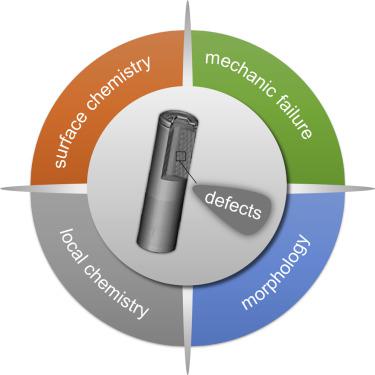Cell Reports Physical Science ( IF 8.9 ) Pub Date : 2021-08-25 , DOI: 10.1016/j.xcrp.2021.100554 Guannan Qian 1, 2 , Federico Monaco 3 , Dechao Meng 1 , Sang-Jun Lee 2 , Guibin Zan 2 , Jizhou Li 2 , Dmitry Karpov 3 , Sheraz Gul 4 , David Vine 4 , Benjamin Stripe 4 , Jin Zhang 2, 5 , Jun-Sik Lee 2 , Zi-Feng Ma 1 , Wenbin Yun 4 , Piero Pianetta 2 , Xiqian Yu 6, 7 , Linsen Li 1, 8 , Peter Cloeten 3 , Yijin Liu 2

|
The manufacturing of commercial lithium-ion batteries (LIBs) involves a number of sophisticated production processes. Various cell defects can be induced, and, depending on their structural and chemical characteristics, they could lead to acute failure and/or chronic degradation. Although tremendous efforts have been devoted to develop a robust quality control (QC) procedure, the functional role of the cell defects is not well understood. Here, we address this question through a systematic experimental study of commercial 18650-type LIBs that have failed the QC inspection due to a self-discharging effect. We identify and recover the defective regions from the cell and conduct a comprehensive investigation from the chemical, structural, and morphological perspectives. Our results reveal how the structural defects affect the cell performance, which is highly important to industry-scale battery production.
中文翻译:

结构缺陷在商用锂离子电池中的作用
商用锂离子电池 (LIB) 的制造涉及许多复杂的生产过程。可以诱导各种细胞缺陷,并且根据它们的结构和化学特性,它们可能导致急性失效和/或慢性降解。尽管为开发稳健的质量控制 (QC) 程序付出了巨大努力,但细胞缺陷的功能作用尚不清楚。在这里,我们通过对由于自放电效应而未能通过 QC 检查的商用 18650 型 LIB 进行系统的实验研究来解决这个问题。我们从细胞中识别和恢复缺陷区域,并从化学、结构和形态学角度进行全面调查。我们的结果揭示了结构缺陷如何影响电池性能,



























 京公网安备 11010802027423号
京公网安备 11010802027423号